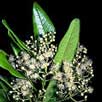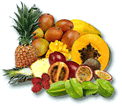April 2002
The Daley News
Allspice Tree - Pimenta dioica
 The name allspice came into usage during the 17th century, stemming from the description that it is a blend of cloves, juniper, pepper, cinnamon and nutmeg. The Allspice tree is closely related to the clove tree, Oleum pimentae. The oil of both spices share the same principal constituent.
The name allspice came into usage during the 17th century, stemming from the description that it is a blend of cloves, juniper, pepper, cinnamon and nutmeg. The Allspice tree is closely related to the clove tree, Oleum pimentae. The oil of both spices share the same principal constituent.
The allspice tree begins to fruit when 7 to 8 years old and it comes into full bearing from 15 years. The small flowers are quickly followed by small berries that resemble that resemble black peppercorns.
The fruits special qualities reside in the rind. The berries are collected as soon as they have reached full size, but while still unripe and green, since they lose their aroma upon ripening owing to loss of their volatile oil.
Harvesting of the berries is performed by breaking off the small twigs that bear the bunches. These are then spread and exposed to the sun and air for a few days, the stalks removed and the berries then ready.
There are both male and female allspice trees. The so-called male trees rarely bear fruit. There is no way to tell which is which before the time of fruiting.
Davidson's Plum
The NSW Davidson's Plum (Davidsonia pruriens var. jerseyana) occurs naturally on the far north coast of New South Wales. It is listed as an Endangered species where as the Qld Davidson's Plum is not considered to be at risk in the wild.
 These versatile and highly ornamental trees can be grown as container plants, bush food plants or as attractive rainforest garden specimens. They are an excellent choice for courtyard or small garden plantings. They mature to between 4 to 6 metres and have a crown of striking burgundy leaves.
These versatile and highly ornamental trees can be grown as container plants, bush food plants or as attractive rainforest garden specimens. They are an excellent choice for courtyard or small garden plantings. They mature to between 4 to 6 metres and have a crown of striking burgundy leaves.
The dark purple fruit of the jerseyana is smaller than its close relative, however it is considered far more flavourful. The brilliant red pulp has a sharp, sour, refreshing taste and is absolutely delicious when made into a tangy crimson jam, delicious wine or rich sauces, both savoury and sweet.
Harvesting periods differ depending on the growing environment however most appear to bear very late or early in the year. With adequate care they will begin bearing from 3 to 5 years. When harvesting it is best to wear gloves as the irritant hairs on the leaves and fruit, or in the jerseyana's case the leaves, can cause itching. Pruriens means itching. The fruit ripens over a 2 to 4 week period.
As is with most rainforest trees they are ideally suited to regions with a moderate to high rainfall, rich well drained soil and shelter from dry, hot and cold winds. They thrive when composted and mulched and need to be kept moist in order to bear good yields. The young trees won't tolerate any frost.
Cold Hardy Citrus
As citrus trees are basically subtropical or tropical I am often asked for information regarding their cold hardiness. Most citrus will not tolerate temperatures below -2 C. For those of you who live in regions where the winter chill regularly falls below this temperature there are many preventative measures and cultural practices you can  follow to grow citrus successfully.
follow to grow citrus successfully.
Cold Hardy Variety Selections
Trifoliate orange is an inedible citrus used as a rootstock. It withstands the lowest temperatures of all citrus followed by kumquat, satsuma mandarin, calamondin, mandarin, orange, grapefruit, lemon, lime and citron. Grapefruit, lemon, lime and citron being cold sensitive. Satsuma and kumquats are the most prominent of the cold hardy citrus.
Cold Hardy Sweet Oranges
Hamlin and Navel Oranges are the most cold tolerant of the oranges. If on trifoliate rootstock they exhibit the maximum cold-hardiness, with swingle and sour orange following.
Cold Hardy Mandarins
The Sunburst Mandarin is one of the most cold hardy again with maximum cold hardiness being achieved when budded onto trifoliata or sour orange rootstock.
Satsuma Mandarins are the most cold-tolerant of commercial citrus, with mature dormant trees having survived temperatures as low as -9C with serious injury. The Satsuma is adapted to regions that are too cold for most other citrus. The Satsuma tree is vigorous, of medium size and very productive. Maximum cold hardiness is achieved when budded onto trifoliate rootstock.
Cold Hardy Kumquats
Kumquats exceed even satsuma in terms of cold-hardiness being able to sustain temperatures as low as -12C when dormant. Trifolate is the recommended rootstock when growing kumquats in cold areas.
Planting site
When planting in cooler climates give some thought to the planting site. Cold air drains downhill so higher elevations are somewhat warmer than sites at the bottom of a slope. Planting citrus near a house or other building will also offer protection. The building will act as a windbreak, forcing cold air up and over it and therefore over the citrus also. The house itself radiates considerable heat some of which will be absorbed by the plants.
Cultural Practices
The soil under and around cold sensitive trees should be free of weeds and mulch. These act as insulators preventing warmth from the sun from entering the soil during the day. This warmth is stores in the soil for release during the night. A clear surface allows maximum heat absorption during the day and maximum heat radiation at night. It is also recommended that soil be kept moist as it will absorb more heat than a dry soil. Keeping your trees strong and healthy through good care will also help them to withstand cold temperatures.
Cold Protection
For more information on how to protect your trees during winter visit the July 2001 newsletter.
Fahrenheit to Celsius Conversion Chart
For those of you in cooler climates you may find this chart interesting when referring to text printed in the USA. It is a simple http://www.crh.noaa.gov/pub/temp2.htm
Kumquats - The cold hardy Jewels of the Citrus Family
Many people think of kumquats as a tart fruit that is only used in preserves. However their are two varieties, the Nagami and Meiwa that are bite-size fruit eaten skin and all. They have a wonderful combination of tangy and sweet flavours. They are becoming more and more common on the supermarket shelves and are an ideal snack for school  lunches. They are delicious eaten straight from the tree but if there are any left over they can be used in salads and marinades or as an attractive garnish in desserts.
lunches. They are delicious eaten straight from the tree but if there are any left over they can be used in salads and marinades or as an attractive garnish in desserts.
Meiwa (synonymous with Marumi) is the sweetest kumquat and has round, sweet tender skin and a sweet tangy centre. Calamondin has tiny round, very tart kumquats and nagami has oblong fruits that have a delicious sweet and tart taste.
The plant itself is highly ornamental as it is almost always covered in either delightfully scented blossoms or bright orange fruit. It is an evergreen shrub with glossy green foliage that make fantastic additions to wreaths and floral arrangements. They are great for planting in containers and can be shaped into topiary forms.
To post your message please Contact Us






